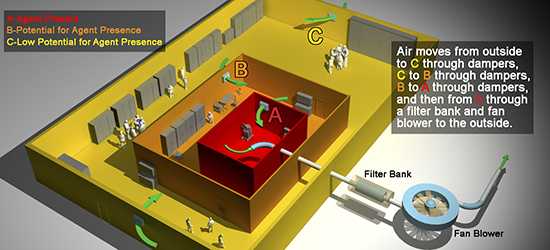Engineering Controls
Engineering controls are the first line of defense in protecting the public when a chemical agent is being destroyed at one of the Department of Defense’s chemical weapons disposal facilities:
- Airborne chemical vapors are contained within the disposal facility by a strong airflow system that pulls air toward the main operations area and special exhaust outlets.
- Strong exhaust airflow means that air can only move in one direction - back into the facility. This keeps contaminated air from escaping from the facility.
- Air captured by the exhaust system goes through special carbon filters that effectively removes the chemical agent.
- Air is monitored throughout the process by sensitive equipment on back-up power supplies to ensure chemical agents do not escape into worker areas or the community.

CDC staff help ensure that engineering controls remain effective by
- Reviewing plans for the engineering controls and ventilation systems before the facility's construction to ensure that proper safeguards are included.
- Evaluating the systems before any chemical agent is introduced into the facility.
- Reviewing monitoring systems throughout the plant and in the exhaust to ensure they are working properly and are accurate.
- Conducting site visits and ongoing evaluations of the systems.
To learn more about the carbon filtration system, read National Research Council’s
Carbon Filtration for Reducing Emissions from Chemical Agent Incineration, 1999
- Page last reviewed: May 31, 2013
- Page last updated: November 2, 2015
- Content source:


 ShareCompartir
ShareCompartir